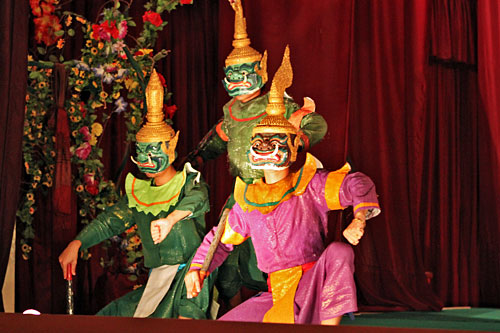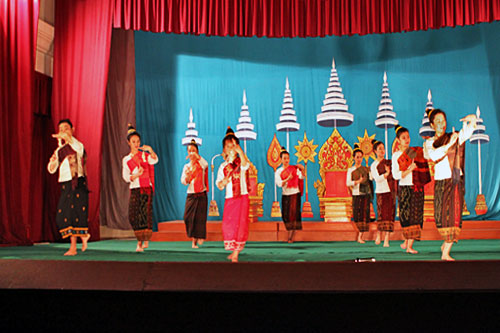The Royal Ballet Theatre troupe in Luang Prabang achieved the impossible on the evening I attended a performance of Phra Lak Phra Lam, the Lao version of the sacred poem known as the Ramayana. Dancers in monkey masks sat on their haunches, scratching the backs of their necks. Tall men wearing hawk-billed masks and elaborate silk costumes glided around the stage flapping their arms. The dancers were so thoroughly in character that reality was suspended; I believed they were monkeys and giant birds of prey.


That the Phra Lak Phra Lam is even performed today is something of a miracle. Unlike the brutal repression of the Khmer Rouge in Cambodia, which killed thousands of monks and destroyed monasteries during their reign, the Pathet Lao communists in Laos attempted to influence Buddhist clergy to achieve political goals. As early as the 1950’s, when the Pathet Lao began to emerge as a political force, they discouraged religious practices deemed counter to the communist philosophy, such as making large donations to monasteries, the tradition of alms giving, and many cultural festivals and activities. When the Pathet Lao officially came to power in 1975 the Phra Lak Phra Lam, which had been performed for members of the royal court for 15 centuries, was banned.
Surprisingly, in 1979 the communist government began easing restrictions, resulting in a gradual resurgence of Buddhist institutions and practices, and by 1993 a committee had been appointed to revive performances of Phra Lak Phra Lam. The theater reopened in 2002 at the National Museum in Luang Prabang, located on the site of the old Royal Palace. The 1.5 hour show, which is every Monday, Wednesday and Saturday at 6:00 p.m., is well worth the $10 price.

Well worded. Thank you for taking the time. I’ll return here to find out more and recommend my acquaintenances about your writing.
Communist countries rather emphasized cultural (though not religious) activities, didn’t they? I remember seeing the Kirov Ballet in Saint Petersburg, back when the city was still called Leningrad. The theatre was completely full and it was not just high brows; it was obvious this was entertainment for everybody. It was wonderful.
It’s true that this ballet is cultural, but has ties to monarchy, anything to do with monarchy or old feudal past was discourage. I lived there around 1975, for some reasons most people never abandon Buddhism even high ranking officials at the time were devout Buddhists themselves. In many ways Laos never became truly communist state (culturally). The origin of the revolution in Laos came from the struggle for independence which is not the same as Russian revolution or French revolution, class thing was never the main issue only small part of it, in that sense religion is also part of the cultural identity which is quite unusual for communist revolution.
I loved Laos Chan; the people are especially gentle and welcoming. Maybe the fact that they never truly embraced Communism or gave up Buddhism has a lot to do with that.
I’ve been always fascinated with the Southeast Asian culture and traditions, they are full of life and color.
This is so beautiful, and how terrific that it has been “reborn” as it were.
This is so beautiful, and how terrific that it has been “reborn” as it were.